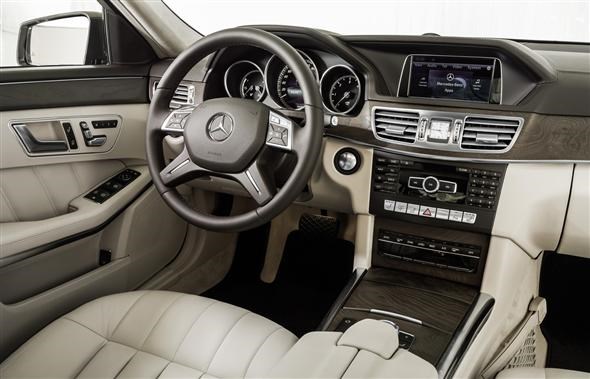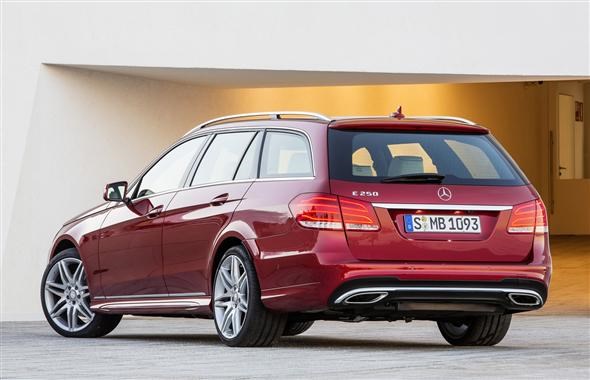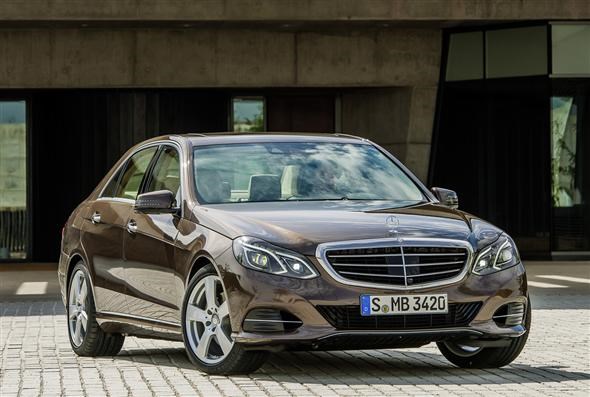The Mercedes-Benz E-Class Saloon and Estate have been given a new look and a range of more efficient engines.
Most obvious is the change in appearance at the front, with new headlamps which are now one single lens rather than the two separate units on the outgoing E-Class. LED light shapes inside the lamps keep the trademark E-Class ‘four-eyed’ look, however. Full LED lights are also now available as an option for the first time.
The front bumper and bonnet are new as well. There are now no lights on the lower part of the bumper and a more pronounced spoiler lip makes the E-Class appear a little more sporty. The taillights have also been updated, with new LED lamps together with a subtly re-shaped rear bumper.
Inside there are new materials, instruments and air vents, together with a new steering wheel with updated gearshift controls.
Of interest to company car drivers will be a new range of more economical engines, all fitted with start/stop systems as standard.
The diesel engine lineup includes BlueTEC models with energy-saving tech such as stop/start and low rolling-resistance tyres. The entry-level diesel, and therefore the one with the lowest P11D value, will be the base E200 CDI model. The most economical diesel to go for is the E220 CDI, which can manage 60.1 mpg and emits 125 g/km CO2, placing it in the 19 per cent band for company car tax. The Estate version is marginally less efficient, emitting 134 g/km for a 20% Benefit-in-Kind band.
There is one petrol engine available, a two-litre turbocharged unit which emits 135 g/km CO2 and achieves 48.7 mpg in the E-Class saloon and marginally less in the estate. This engine is fitted to the E200 and E250 models in two stages of power: 181bhp or 208bhp respectively.
As before, an E300 BlueTEC Hybrid version will be available which combines a four-cylinder diesel engine with an electric motor and achieves 69.0 mpg with CO2 emissions of 107 g/km. Although it’s the most efficient of the E-Class, its P11d value is likely to be a lot higher than the diesel models so it won’t be any cheaper to tax.
There is a choice of two transmissions, a six-speed manual or Mercedes’ 7G-Tronic Plus automatic with steering-mounted shift paddles.
The new E-Class has been fitted with a new collection of driver assistance systems which Mercedes-Benz has called “intelligent drive.” The systems make use of a new stereo camera system behind the windscreen. In place of the single camera fitted before, there are now two separate cameras which work together to monitor the area 50 metres ahead of the car. They can detect and identify oncoming or crossing vehicles and pedestrians appearing in front of the car.
Some of the Intelligent Drive systems can also be expected to appear on the next Mercedes S-Class.
Saloon and Estate versions of the E-Class will come with Collision Prevention Assist as standard, which uses radar to warn of collisions and apply the brakes automatically if necessary. There’s also a driver fatigue warning system.
The range of optional extras available includes lane-keeping assist, headlamp high beam assist, parking assist (which can automatically steer the car into parallel and bay parking spaces), blind spot assist and a 360-degree camera display to help with maneuvering.
A number of multimedia and navigation systems with internet connections are fitted as standard.
Four suspension configurations can be had, ranging from comfort-oriented to more sports-focused set ups. The Estate version gets air suspension with electronically controlled damping.
The new Mercedes-Benz E-Class will get its first public showing in the new year. Prices are yet to be confirmed, but the current range starts below the £30,000 mark, rising to more than £40,000 for high-end 350-series models.







